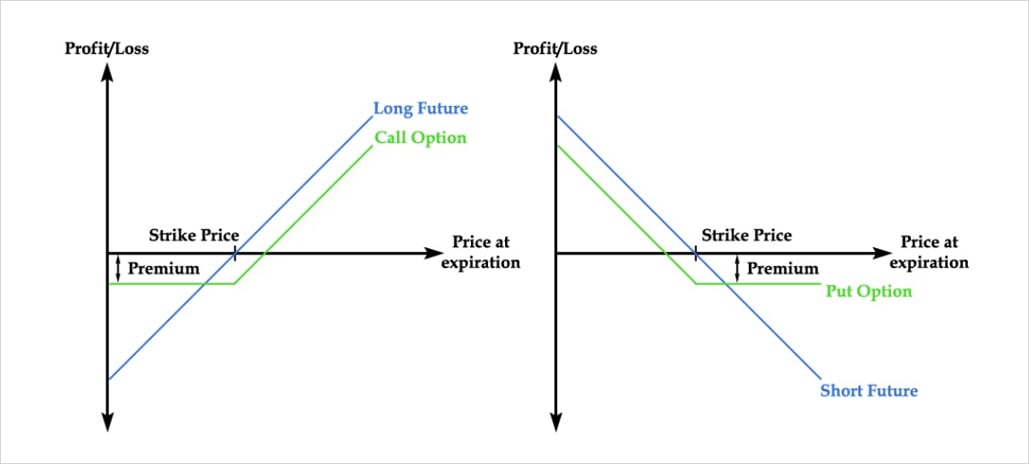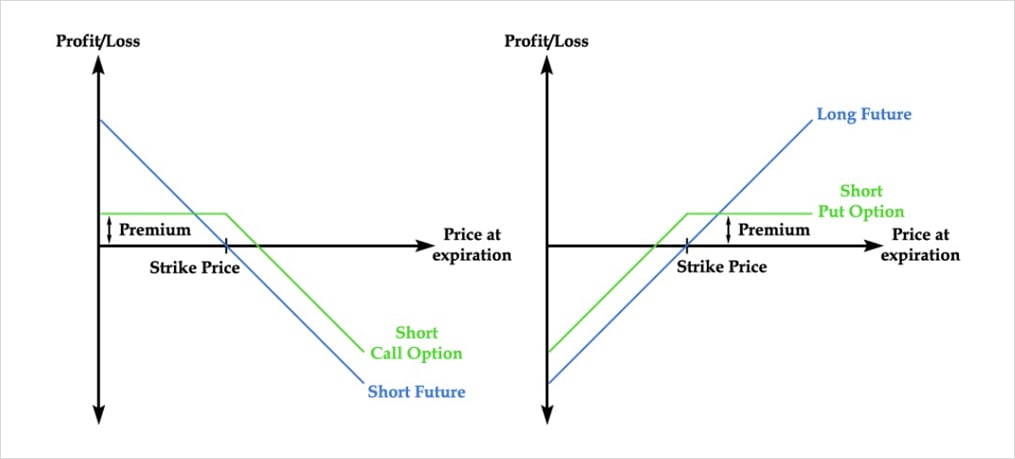There are two types of options – call options and put options.
A call option is the right to buy the underlying asset at the strike price on the expiry date. The buyer of a call option is betting on the price of the asset going up.
A put option is the right to sell the underlying asset at the strike price on the expiry date. The buyer of a put option is betting on the price of the asset going down.
Specifications of an options contract:
- Underlying asset – The underlying asset, the price of which is being speculated on, for example Bitcoin.
- Expiry date – The date the option will expire and be exercised, after this date, the contract is no longer valid.
- Strike price – The price at which the buyer has the right to buy or sell the underlying asset at expiry.
- Option type – Call or put
- Option price (premium) – The price the buyer pays to the seller for the right to buy or sell the asset at the strike price on the expiry date.
All options on Deribit are European style, which means they can only be exercised at expiry, unlike American style options, that can be exercised any time until expiry.
Options on Deribit are also cash settled, which means when they are exercised it is only the profits that are paid.
For example if a Bitcoin call option with a strike price of $5,500 expires when the Bitcoin price is $6,000, then $500 would be the profit paid from the seller to the buyer.
On Deribit options are exercised automatically at expiry, meaning any intrinsic value remaining is paid as profit from the seller to the buyer. If the option expires worthless, then nothing is paid.
Closing an option position early
European options are not exercised until the expiry date, however this does not affect your ability to buy and sell the option freely before that date. For example, if you bought a call option with 30 days left to expiry and wanted to sell it just 5 days later after an increase in the price, you are free to do so.
Abbreviation of options contracts
On the Deribit platform and in the API you will see option instruments named like this:
BTC-27DEC19-5500-C
This option is for the underlying asset of Bitcoin, an expiry date of 27th December 2019, a strike price of $5,500, and it is a call option.
- More generally this format can be written as:
Underlying Asset – Expiry Date – Strike Price – Option Type
The option contract price is displayed separately in the order book for each option and varies over time depending on the market conditions.
Buying Options
The chart below shows the profit and loss curve for buying a call option (left) and buying a put option (right) versus a regular long futures or short futures position respectively.

Unlike with a futures position, buying an option has limited risk, which is the premium paid. Paying this premium shifts the whole P/L line for the option buyer down the P/L axis by the amount paid, however still gives exposure to almost all of the possible profit of the corresponding futures position.
You may be an option buyer because:
- You want to limit your risk while still having large profit potential
- You want to take a position that cannot be stop hunted or liquidated
- You are predicting a large price movement or an increase in implied volatility
Downsides to being an option buyer:
- You have to pay a premium for the option
- If the price fails to move, your option will lose value every day
- There is a time limit for your trade to work out, as the option has an expiry date
Selling (writing) Options
Options on Deribit can be bought and sold. Even though you are trading the same contract, buying and selling options are very different in terms of risk and profit.
An option buyer has the right, but no obligation, however, an option seller has an obligation but not a right.

This results in option buyers having limited risk and (almost) unlimited profit potential. Conversely option sellers have limited profit and (almost) unlimited risk.
The chart below shows the profit and loss curve for selling a call option (left) and selling a put option (right) versus a regular short futures or long futures position respectively.

Option sellers’ profit is limited to the premium collected for selling the option. However option sellers have exposure to almost all of the possible risk the corresponding futures position would have.
You may be an option seller because:
- You want to collect the premium for the option
- Time decay works in your favour, if there is no price movement, you will make a profit
- You are predicting small price movements and/or a decrease in implied volatility
- You can profit from the market’s tendency to overestimate future volatility
Downsides to being an option seller:
- You have limited profit, but unlimited risk
- If you are wrong in your predictions, you can experience very fast losses and you can lose far more than the premium collected
Options allow a trader to use far more advanced trading strategies, that are not possible with other instruments. You will be able to learn more about options in the upcoming lessons.
There is still plenty to cover, however, now you should be more familiar with the basics of options contracts and their revenue potential.
AUTHOR(S)
